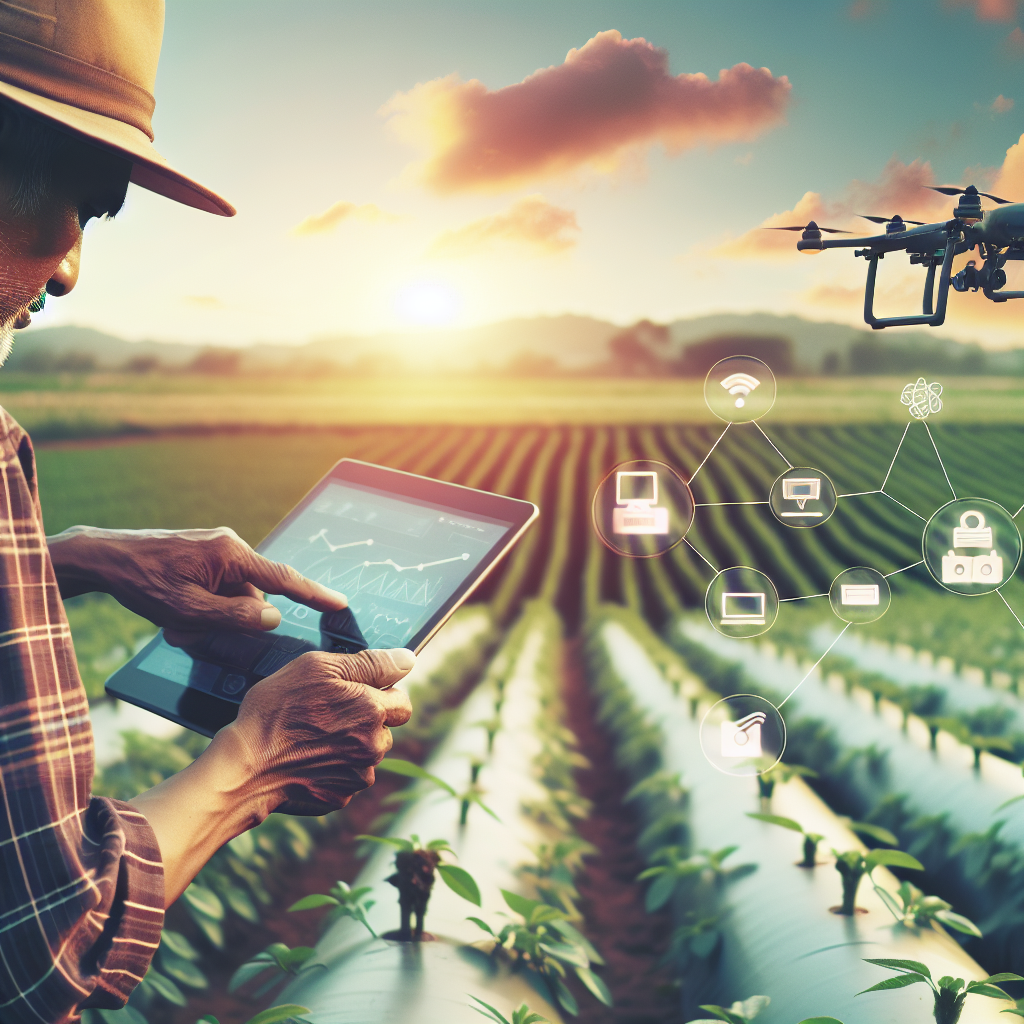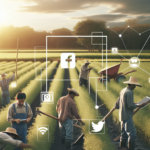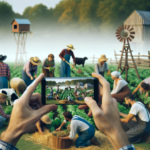Introduction to Smart Technology in Farming
Have you ever wondered about the tools and systems that make today’s agriculture smarter and more efficient?
The integration of smart technology in climate farming is no longer a matter of the future; it’s advancing agriculture practices right now.
This article examines smart technology in climate farming, what it includes, and the pivotal role it has in agricultural productivity and environmental sustainability.
From the Internet of Things (IoT) connectivity and the integration of Artificial Intelligence (AI) to futuristic concepts like cloud-based farms, we’ll explore how this environmentally conscious technology is reducing agriculture’s carbon footprint, increasing yields, and addressing challenges along the way.
To gain a clear insight into all the facets of this exciting digital revolution in farming, let’s take a closer look!
Table of Contents
What is Smart Technology in Climate Farming?
Overview of Smart Technology in Agriculture
Smart technology in climate farming involves using advanced tools and systems to optimize agricultural practices. This integration enhances productivity and reduces environmental impact.
Key Components of Smart Technology
- Internet of Things (IoT)
- Artificial Intelligence (AI)
- Data Analytics
- Automation Systems
Internet of Things (IoT)
IoT connects devices and systems, enabling real-time monitoring and management.
- Soil Sensors: Measure moisture, nutrient levels, and temperature.
- Weather Stations: Provide localized forecasts and climate data.
- Livestock Trackers: Monitor health, location, and activity.
Artificial Intelligence in Climate Farming
AI helps make informed decisions and predictive models.
- Yield Predictions: Analyze historical data and weather forecasts.
- Pest Detection: Use image recognition for early identification.
- Resource Allocation: Optimize water, fertilizer, and pesticide use.
Data Analytics for Better Decisions
Data analytics processes vast amounts of information collected from various sensors.
| Type | Function |
|---|---|
| Predictive Analytics | Forecast crop yields and market trends. |
| Descriptive Analytics | Analyze past performance to improve practices. |
| Prescriptive Analytics | Provide actionable recommendations. |
Automation Systems in Climate Farming
Automation reduces manual labor and increases precision.
- Robotic Harvesting: Increases efficiency and reduces waste.
- Automated Irrigation: Ensures optimal water use.
- Drone Technology: Monitors crops and applies treatments.
Environmental Benefits of Smart Technology
Smart technology significantly reduces agriculture’s environmental footprint.
- Water Conservation: Precision irrigation minimizes water usage.
- Reduced Chemical Use: Targeted treatment lowers pesticide and fertilizer application.
- Lower Emissions: Efficient operations cut down greenhouse gas emissions.
Challenges and Considerations
While smart technology offers numerous benefits, it comes with challenges.
- High Initial Costs: Investment in technology can be expensive.
- Data Security: Safeguarding sensitive information is paramount.
- Technical Expertise: Skilled labor is required to manage advanced systems.
For more information, check out the latest advancements in climate farming technology on Forbes.
Experienced Farmers to Technology Enthusiasts: Next Level of Applications
Cloud-Based Farms: Sky’s the Limit
Arguably the latest frontier of climate smart agriculture, cloud farming expands the possibilities of traditional farming. Essentially, cloud-based farming platforms gather data from various sources providing comprehensive insights for farmers. This centralization aids in better decision-making and swift problem-solving for rural areas.
Emerging Elements in Smart Tech Agriculture
- Blockchain: Provides reliable and transparent supply chain tracking.
- Augmented and Virtual Reality (AR/VR): Assists in training and crops surveillance.
- Machine Learning: Improves upon AI algorithms for better predictive analysis.
Blockchain in Agriculture
As a publicly accessible ledger, blockchain is an unalterable record of transactions. By harnessing blockchain, farmers and consumers have full traceability of products, ensuring safety, quality control, and fair trade practices.
- Supply Chain Visibility: Ensures transparency from farm to fork.
- Contract Farming: Facilitates trust between farmers and buyers.
- Product Authenticity: Guarantees the provenance of agricultural products.
AR/VR: New Perspectives
Augmented and virtual reality technologies provide an immersive experience, going beyond traditional visualization methods. This tool, although typically associated with gaming, is proving useful in agriculture for training, crop scouting, and remote consultations.
- Training Enhancement: Provides realistic virtual situations for learning.
- Crop Scouting: Offers a 360-degree view of the farm without physically being there.
- Remote Expert Input: Allows authorities to visualize reality and provide inputs from miles away.
Machine Learning’s Evolution
Complementing AI, machine learning adds another layer of expertise through iterative learning. This feature improves data analysis, predictive power, and problem-solving with minimal human intervention.
| Domain | Implementation |
|---|---|
| Plant Diseases | Identify disease patterns for early detection and prevention. |
| Yield Forecasting | Accurate predictions with changing weather pattern consideration. |
| Improved Drones | Autonomous navigation and targeted crop sprays. |
Problem Solvers or New Problems?
As these new technologies continue to make agricultural practices efficient and sustainable, they also introduce novel challenges to handle.
- Complexity in Implementation: More advanced technologies demand greater understanding.
- Legal Implications: Data and privacy concerns may lead to legal disputes.
- Accessibility: Ensuring equal benefits to all farmers, irrespective of scale, is essential.
To learn more about the latest developments in smart technology for climate farming, read this Nature article discussing the improved accuracy of yield forecasting with machine learning.
What Equipment is Used in Climate Smart Agriculture?
Precision Farming Solutions
Climate smart agriculture greatly benefits from precision farming equipment designed to make site-specific decisions based on real-time data. This technology allows for efficient resource management.
- GPS-Enabled Tractors: Enhance planting accuracy and reduce overlapping operations.
- Variable Rate Technology (VRT): Adjusts input rates for seeds, fertilizers, and pesticides based on soil and crop needs.
- Drones: Equipped with multispectral cameras for crop health monitoring and targeted pesticide application.
Environmental Monitoring Tools
Continuous monitoring of environmental conditions is essential in climate smart agriculture. Specialized equipment plays a vital role in gathering this data.
- Weather Stations: Provide hyper-local weather data to inform irrigation schedules and pest management.
- Soil Moisture Sensors: Track water levels and optimize irrigation systems, conserving water.
- Air Quality Sensors: Measure pollutants and greenhouse gases to improve farm sustainability.
IoT-Integrated Equipment
Harnessing the power of the Internet of Things (IoT), agriculture equipment integrates various sensors and tools to provide comprehensive farm management solutions.
- Smart Irrigation Systems: Automate watering schedules based on real-time data, reducing water waste.
- Field Monitoring Devices: Capture in-field data on crop health and soil conditions, sending real-time alerts.
- Livestock Health Monitors: Wearable devices track the health and activity of livestock, allowing for remote management.
Robotic Technology in Agriculture
Robotics has introduced new levels of efficiency and precision in agriculture, addressing labor shortages and enhancing productivity.
- Autonomous Tractors: Self-driving tractors perform tasks like plowing, planting, and harvesting with minimal human oversight.
- Weed Control Robots: Automated machines detect and eliminate weeds using mechanical or chemical methods.
- Robotic Harvesters: Efficiently pick fruits and vegetables, reducing waste and labor costs.
Unmanned Aerial Vehicles (UAVs)
Drones, also known as Unmanned Aerial Vehicles (UAVs), have become indispensable in modern agriculture for their versatility and high efficiency.
- Crop Scouting: Drones provide aerial views to monitor crop health and detect issues like disease or pest infestations early.
- Spraying: Equipped with precision sprayers, drones can deliver pesticides and fertilizers uniformly and efficiently.
- Mapping: Generate 3D maps of fields to plan planting strategies and analyze soil variations.
Read more about the integration of these technologies in climate smart agriculture by visiting this ThoughtCo article.
How is Technology Used in Farming?
Advanced Agronomic Tools
The use of technology in farming has revolutionized the agricultural landscape. By integrating various advanced tools and systems, farmers can optimize their productivity and reduce the environmental impact of farming.
Sensors for Precision Agriculture
Sensors are essential for precision agriculture, providing detailed, real-time data to enhance decision-making processes.
- Soil pH Sensors: Measure soil pH levels to determine the need for lime or fertilizers.
- Canopy Sensors: Evaluate crop health by detecting chlorophyll levels.
- Electrical Conductivity Sensors: Assess soil salinity and fertility.
Satellite and Aerial Imagery
Satellite and aerial imagery play a significant role in modern farming, aiding in various agricultural processes.
- Crop Monitoring: Identify crop stress areas, pest infestations, and disease presence through multispectral and hyperspectral imaging.
- Land Mapping: Create accurate maps for field planning, irrigation design, and soil management.
- Yield Estimation: Use crop growth models and satellite data to estimate yields before harvest.
Geographic Information System (GIS)
GIS combines spatial data and various types of information to provide actionable insights about the farm.
- Field Management: Facilitate data layers like soil type, crop yield, and field boundaries for comprehensive management.
- Pest Management: Identify pest hotspots and implement targeted interventions.
- Sustainability Planning: Monitor environmental conditions to promote sustainable practices.
Biotechnology in Farming
Biotechnology has enabled the development of superior crop varieties and improved farming methodologies.
- Genetically Modified Organisms (GMOs): Enhance crop resilience to pests, diseases, and environmental conditions.
- Biofertilizers: Use microbial inoculants to enhance soil nutrient availability.
- Biopesticides: Implement natural predator-based or microbial-based solutions for pest control.
Cloud Computing in Agriculture
Cloud computing brings powerful data storage and processing capabilities to the farming sector.
- Farm Management Systems: Cloud-based platforms streamline data storage, analysis, and decision support for farmers.
- Weather Forecasting: Improved access to weather data through cloud services helps farmers plan activities based on accurate forecasts.
- Data Integration: Seamlessly integrate data from various sensors, devices, and systems for holistic farm management.
Integrated Pest Management (IPM) Tools
IPM strategies leverage technology to manage pest populations in an economically viable and environmentally responsible manner.
- Pheromone Traps: Use chemical signals to monitor and control pest populations.
- Drone Surveillance: Utilize UAVs to detect early signs of pest invasions and precisely apply control measures.
- Biological Controls: Implement natural enemies of pests to maintain pest populations at manageable levels.
Consequently, technology continues to play a vital role in transforming and evolving the agricultural industry. For an in-depth look at some of the latest technologies driving agriculture forward, refer to this MIT Technology Review article.
Agriculture Reimagined: Going Beyond Traditional Boundaries
The seamless integration of smart technologies and innovative methods, as shown in the article, is challenging traditional farming practices and revolutionizing the agriculture sector.
From weather forecasting with IoT and improving crop quality using AI to predictive data analytics, and the use of automation for efficient operations, cutting-edge technology is at the forefront of this agricultural transformation.
Further advancements such as cloud-based farming, Blockchain, AR/VR, and Machine Learning are also changing the dynamics of farming by providing more control, precision, and environment-friendly solutions.
While cutting-edge farming tools and intelligent systems like GIS, biotechnology, and cloud computing propel us into the future of farming, challenges like high initial costs, data security, and technical expertise still need to be addressed.
Frequently Asked Questions – FAQs
What is smart technology in climate farming?
Smart technology in climate farming refers to the use of advanced systems and tools, like IoT, AI, Data Analytics, and Automation Systems, to enhance agricultural practices, yield, and reduce environmental impact.
How does IoT, AR/VR and AI help in farming?
IoT connects various devices to enable real-time monitoring and management. AR/VR provides immersive experiences for training, crop scouting, and remote consultations. AI strengthens decision-making process with predictive models and data analysis.
What are some emerging elements in farming technology?
Emerging elements in farming technology include Blockchain for transparent supply chain tracking, AR and VR for enhanced training and monitoring, and Machine Learning to improve data analysis and predictive power.
What equipment is used in climate smart agriculture?
This includes precision farming solutions, environmental monitoring tools, IoT-Integrated Equipment, Robotic Technology, and Unmanned Aerial Vehicles (UAVs).
How has technology changed farming practices?
Technology, by integrating advanced agronomic tools, sensors, satellite imagery, GIS, biotech, and cloud computing, has improved productivity, sustainability, and environmental impact of farming. It has also enhanced pest management and data integration.






